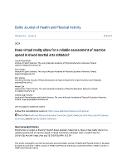Does virtual reality allow for a reliable assessment of reaction speed in mixed martial arts athletes?

Autor
Polechonski, Jacek
Langer, Alan
Zak, Marcin
Zajac-Gawlak, Izabela
Maszczyk, Adam
Datum vydání
2024Publikováno v
Baltic Journal of Health and Physical ActivityRočník / Číslo vydání
16 (3)ISBN / ISSN
ISSN: 2080-1297ISBN / ISSN
eISSN: 2080-9999Metadata
Zobrazit celý záznamKolekce
Tato publikace má vydavatelskou verzi s DOI 10.29359/BJHPA.16.3.09
Abstrakt
Introduction: The immersive virtual reality (VR) might bring a new reliable approach to diagnosing motor abilities. Therefore, the main goal of this research was to check the intertrial reliability and diagnostic possibility (reaction time, movement time, lateral differences) of VR for upper limb movements in a group of mixed martial arts (MMA) athletes, and to evaluate whether distractors influence the complexity of the whole reaction. Material and methods: Twenty-six MMA athletes (age 27.1 +/- 5.4 years, body mass 77.6 +/- 9.3 kg, height 179.2 +/- 5.7 cm, training experience 6.7 +/- 4.3 years) performed two reaction tests for their upper limbs (four tests were made for the ICC calculation) with wireless autonomous VR. Results: The ICC values ranged from 0.751 to 0.872 in simple reaction speed and 0.709 to 0.909 in complex reaction. No significant differences were observed between the reaction of the right and the left upper limbs. Distractors were shown to negatively affect the speed (d d = 1.2) and reaction time of complex reactions (d d = 1.3). Conclusions: The implemented VR measurement system allows for a reliable assessment of simple and complex reaction speed and its components (reaction time, movement time) for upper limb strikes and covers in MMA athletes. MMA reaction time of upper limbs is laterally balanced in MMA athletes. The disruptor causes a large decrease in reaction speed and prolongs the reaction time. Therefore, a test with a disruptor might have the potential to recognize performance level and athletes' reaction abilities.
Klíčová slova
MMA, VR, physical activity, FitLight Trainer, BlazePodTM,
Trvalý odkaz
https://hdl.handle.net/20.500.14178/2679Licence
Licence pro užití plného textu výsledku: Creative Commons Uveďte původ-Neužívejte dílo komerčně-Nezpracovávejte 4.0 International






